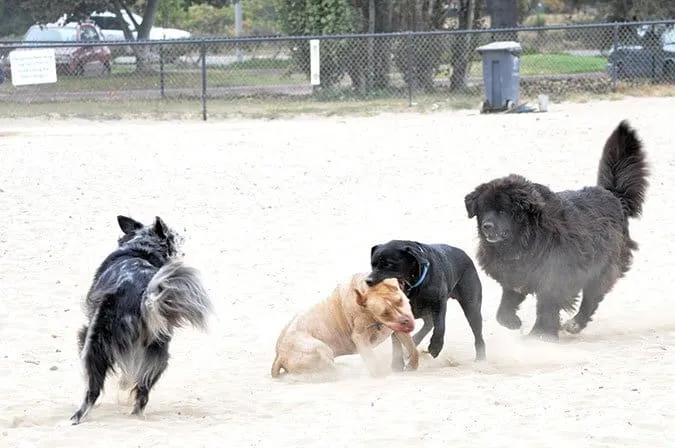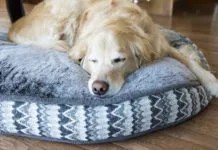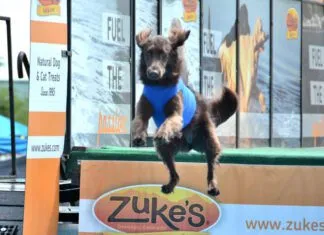The most successful dog parks have rules – and people who enforce them. Registration and numbered armbands make it easier to identify rule-breakers, which helps with enforcement. Here are seven dog park rules recommended by professional trainer Pat Miller, CBCC-KA, CPDT-KA:
1. Dogs must be currently licensed and up-to-date on vaccinations and parasite control.
This means dogs owners should be prepared to show current vaccination papers to authorities who request them, and dogs with obvious parasite infestations (internal and/or external) will be asked to leave the park and allowed to return only with a clean bill of health from a veterinarian.
2. No babies, toddlers, or small children allowed in the dog park.
Communities may set different age limits, but seven is a reasonable minimum age for children. Smaller, younger children are just too vulnerable to injury even from friendly dogs who get excited.
3. Owners must pick up after their dogs.
Always, no excuses, no exceptions. Good parks have well-maintained waste stations and keep poop-bag dispensers well-stocked.
4. No dogs in season.
Female dogs in heat don’t belong in dog parks. Period.
5. No aggressive dogs.
Dog parks are not the appropriate place for owner to try to modify their dogs’ aggressive behavior. Dogs who have demonstrated aggression to dogs or humans should not be allowed to return to the park.
6. Owners must be attentive to their dogs.
Much inappropriate dog park behavior could be avoided if humans were paying attention and intervened before canine behavior escalated out of control.
7. All gear needs to be removed from the dogs.
All gear, except for a collar with a quick-release buckle, should be removed from dogs before they enter the park. Harnesses, choke chains, pinch collars, and head halters pose special risks to the dogs wearing them and any dog who might become entangled in them while playing.









This is a good start but it’s not enough. I recommend the following:
4. Add in that bitches in heat can smell attractive and invite unwanted interest to another male for up to a month afterwards. This is when bitches start to hate the approach of another dog but she still smells inviting to them.
6. Add in that people should watch the reaction of the dog their dog is playing with. Do they think the other dog is enjoying their dog’s intensity or play style. If they were to stop their dog would that other dog come back and play or appear to be relieved and go away. It’s hard to educate dog body language but this is a simple test of of play being 50/50.
8. If someone is recalling their dog everyone should recall their dog. It’s good practice of recall and release so it doesn’t mean end of play and can help the person that can’t catch their dog.
9. What to do in the inevitable event of a dog scuffle.
10. Ball obsessed dogs should not be playing fetch in the dog park around other dogs. These dogs are often hyper- aroused and possesive and can cause a fight when another dog tries to steal the ball for attention. The hyper-arousal of ball obsessed dogs can affect the other dogs in the park. I advise my clients to leave when they see this come into the dog park.
Lynne, excellent additions and important points. Dog owners need to be willing to take responsibility, educate themselves on dog behaviour, and stop blaming the other owner or dog. The dog park near me is tantalizingly close and convenient, but I refuse to take my German Shepherd there. My previous dog grew up in this park and for a few years, it was great. But increasingly there were more inattentive owners, out-of-control dogs, and an overwhelming lack of responsibility. Like driving — you can be the best driver on the road, but it’s all the other careless drivers that will get you into trouble. You can only control your own dog, so I choose to walk my dog on-leash, for her safety and mine. Still, too many people walking outside the dog park with their dogs off-leash, with no recall skills to speak of. But that’s another story!
One more rule: No food in the dog park! Some folks show up with a bag of dog treats, then get upset when a dog won’t leave them alone. It’s like the ball obsessed dogs, but food is even higher value than balls.
No non-neutered or spayed dogs! Reduces fights and keeps low-lifes.
One of my big issues with dog parks that needs to be addressed; small dog side for dogs 25 or 30 lbs and under DOES NOT translate to puppies of all breeds and sizes have free reign. I am tired of protecting my chihuahua from playful 60 lbs clumsy puppies no matter how friendly. Your oversized rottie or whatever is too big. Most little dogs feel threatened by size and can become aggressive. Besides which your ox of 50-60-70 lbs can injure my dog by accident The sign DOES NOT READ small dogs under 30 lbs or insecure, shy oversized puppies.